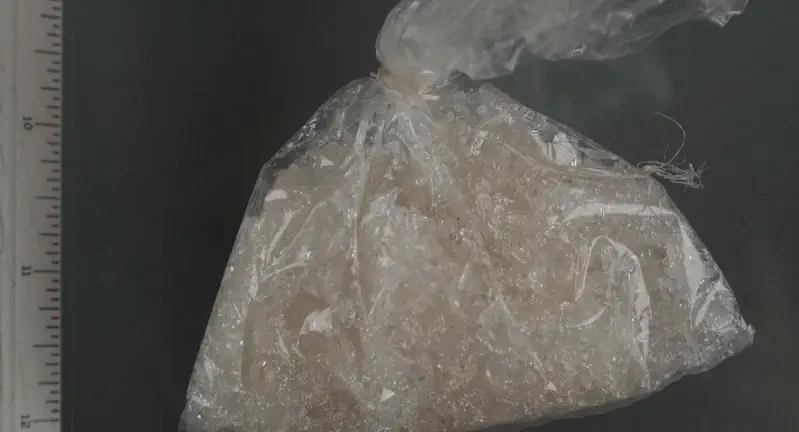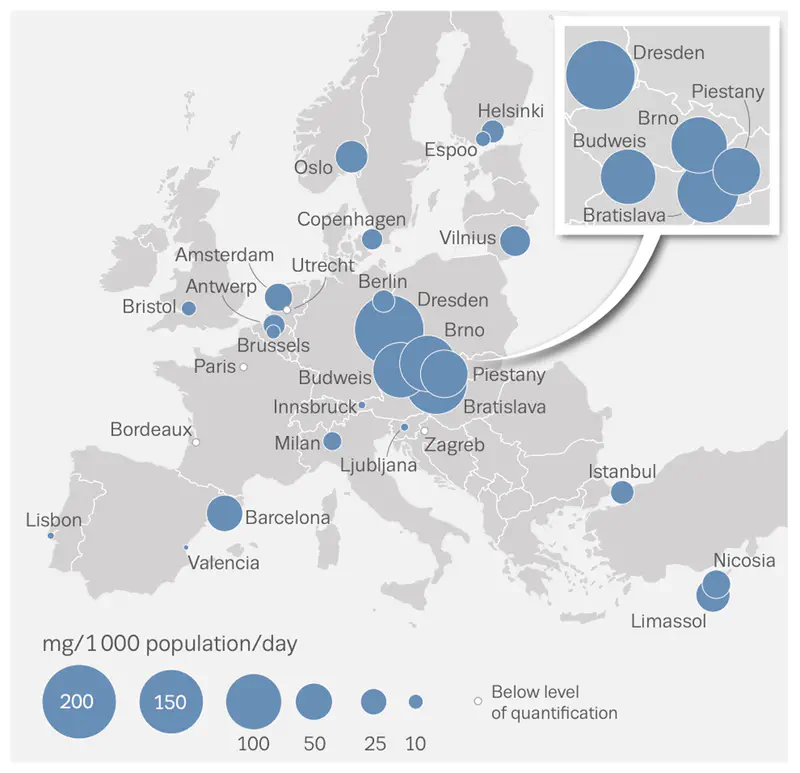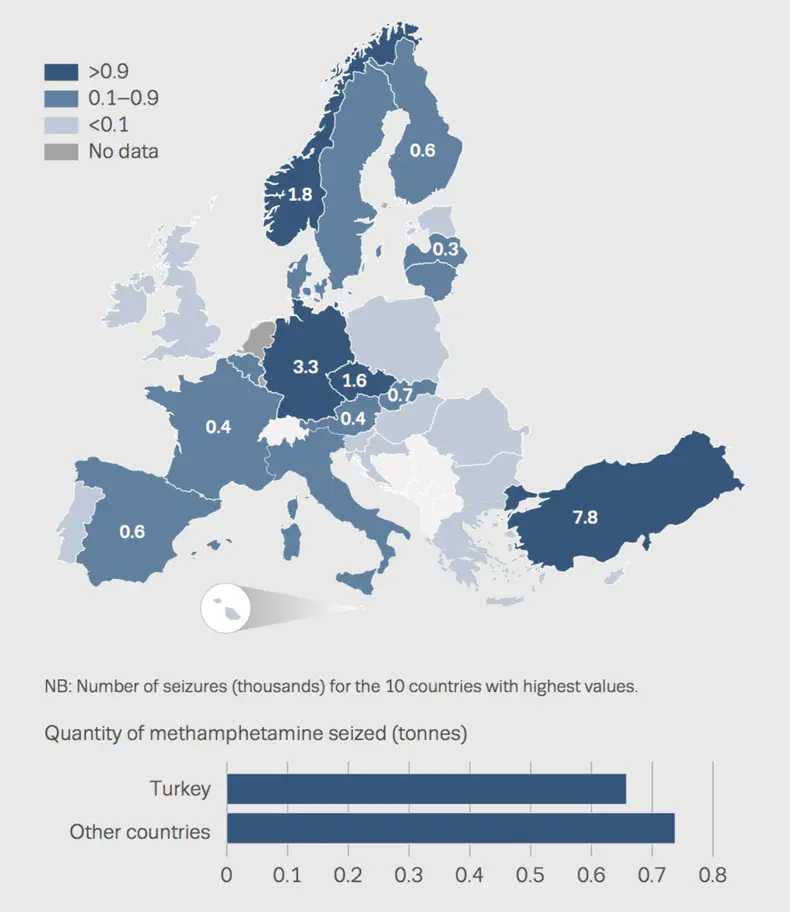DRUGS: WHAT YOU
NEED TO KNOW Booklet

Signs and Symptoms of Methamphetamine Use

Courtesy of DEA.gov
Meth is a powerful stimulant that helps a person stay awake for days if there is enough of the drug on hand to keep renewing the high.
It gives a person a false sense of well-being and confidence, along with other effects and symptoms1such as:
- Sweating
- Rapid breathing
- Rapid heart rate
- Increased blood pressure
- Insomnia
- Tremors
- Lack of appetite
- Talkativeness
- Excitement
- Euphoria
Those symptoms may not sound so severe. There is a high price to pay for this euphoria and excitement, however.
Long-term use often results in these problems:
- Mood swings
- Violent behaviour
- Anxiety
- Paranoia
- Hallucinations
- Cardiac arrhythmia
- Damage to teeth and jaw structures
- Collapse at the end of a binge
- Psychosis
- Neglect of health and hygiene
- Cognitive and emotional changes
High dosages can overstimulate the body so much that these problems occur:
- Ventricular fibrillation (a life-threatening heart rhythm problem)
- Heart attack
- Cardiovascular collapse
- High fever
- Coma
- Muscle breakdown
- Cerebral haemorrhage
- Seizures
- Kidney failure
- Delirium
- Death
Changing Patterns of Supply and Use
Historically, concerns about methamphetamine have taken a back seat to concerns about cocaine, amphetamine or MDMA because methamphetamine had lower numbers of trafficking and use.2 That may be changing. Several signs now point to an increase in the availability of this drug, including the dismantling of many more production facilities in more countries than in previous years.
For many years, methamphetamine trafficking and use was concentrated in the Czech Republic (where it was called pervitin) and Slovakia. In the Czech Republic, the use of meth reached epidemic levels in the 1970s, although use fell after that.3 Even so, Czech users tend to be heavier users and generally require more visits to rehab before they achieve sobriety.
The Czech Republic has long been known for its manufacture of this drug.4 In 2008, for example, there were 438 meth production facilities destroyed in Europe. All but 26 of them were located in this small country. As mentioned above, however, this trend has been changing.
In recent years, wastewater tests show the spread of methamphetamine to more countries.5 These analyses of drug residues in sewage in 2018 and 2019 revealed increasing use in Germany, Spain, Denmark, Lithuania, Finland and Norway, as you can see in this chart.

Courtesy of the European Monitoring Centre for Drugs and Drug Addiction
There is also evidence that increased quantities of methamphetamine are being produced in Europe for shipment to countries outside of Europe.2 According to the U.S. State Department, Mexican drug cartels are also expanding their supply of smokable crystal methamphetamine to both Eastern and Western Europe.6
In June 2019, Dutch police announced the seizure of 2.5 tonnes of methamphetamine in an office building in Rotterdam.7 The street value of such a haul totals in the hundreds of millions of euros.
This city has one of the busiest ports in the world and that office building is connected to Spanish and Mexican companies. A busy port with ships coming and going constantly is ideal for drug traffickers. Because of the huge volume of this stash, it was thought that this supply was intended for other countries, not just the Netherlands.
Statistical Information on Meth
This chart from a 2019 report from the European Monitoring Centre for Drugs and Drug Addiction provides a general idea of where methamphetamine has been seized.8

Courtesy of the European Monitoring Centre for Drugs and Drug Addiction
The next year’s report noted two significant changes: 9
- Turkey’s seizures increased from 7,768 to 13,049
- Finland’s seizures dropped from 1,821 to just 349.
Germany’s high number of meth seizures may not be surprising since it is the top European country for exports of ephedrine, a precursor chemical for the manufacture of methamphetamine.6
In fact, Germany is the number two country in the world for the production of both ephedrine and pseudoephedrine, the other chemical that can be used to make methamphetamine. Only India exports more of these chemicals. These chemicals are also commonly found in over-the-counter decongestants.
A Truly Dangerous Drug
One of the problems with methamphetamine is that it is fairly easy to manufacture if one can get the precursor chemicals. This simple-to-make drug can be manufactured anywhere that criminal elements can set up a simple lab.

A second problem associated with this drug is its intense addictiveness and the difficulty recovering from the addiction. The intensity of addiction to this drug was described by one person in recovery: “It’s like God tells you that if you take another breath, your children will die. You do everything you can not to take a breath. But eventually, you do. That’s what it’s like. Your brain just screams at you.” 10
The third problem is the intense toll methamphetamine takes on a user’s mind, body and quality of life. The drug is closely associated with criminality and social decline.11 Heavy, long-term users suffer neural damage and harm to their ability to think clearly. Cardiovascular damage means that heart attacks and strokes are more likely.
Methamphetamine Use by Youth
The European School Survey Project on Alcohol and Other Drugs (ESPAD) is published every four years to report on drug use by 15 to 16-year old students in 35 countries.12 In the 2015 report, only about 1% of these students reported that they had initiated use of methamphetamine or amphetamine, with boys more likely than girls to have reported use. The exception was in Bulgaria (3%), where more students reported that this drug was easy to acquire.
Treatment Statistics
In treatment statistics, those addicted to methamphetamine are combined with those addicted to amphetamine or other stimulants such as MDMA or prescription stimulants. In the statistics below, you can see this represented in numbers.
Distribution of those entering treatment for amphetamine-type stimulants (percentage of the total number):
- Austria 6.4%
- Belgium 10.2%
- Czechia 51.4%
- Denmark 6.6%
- Finland 21.3%
- France 1.0%
- Germany 14.5%
- Hungary 13.8%
- Italy .3%
- Netherlands 6.4%
- Norway 11.1%
- Portugal .6%
- Spain 1.8%
- Sweden 9.9%
- Switzerland 2.9%
While the number of people using methamphetamine may be lower than the number using drugs like cannabis or cocaine, it can take a disproportionately devastating toll on the user. From heart attacks to incurable neurological damage, methamphetamine can create a dark world from which it is extremely hard to escape.
Sources:
-
Carlo De-Carolis, et al.; US National Library of Medicine National Institutes of Health—PMC (2015), “Methamphetamine abuse and “meth mouth” in Europe” PMC Article ↩︎
-
European Monitoring Centre for Drugs and Drug Addiction & EUROPOL (2019), “Methamphetamine in Europe”. EMCDDA & EUROPOL Article (PDF) ↩︎ ↩︎
-
Tomas Zabransky; National Institute on Drug Abuse— Centre for Addictology/Charles University, Czech Republic (2007), “Methamphetamines in the Czech Republic—History and Current Situation”. NIDA Article ↩︎
-
Bruce I. Konviser TheWorld—Politics (2010), “Czech Republic leads Europe in meth labs” The World News Article ↩︎
-
European Monitoring Centre for Drugs and Drug Addiction (2020), “New study on wastewater analysis shines light on city drug use—Latest wastewater data reveal drug-taking habits in 68 European cities — traces of stimulant drugs rise again” EMCDDA Article ↩︎
-
US Department of State Bureau of International Narcotics and Law Enforcement Affairs (2020), “International Narcotics Control Strategy Report—Volume 1—Drug and Chemical Control” US Dept. of State Report (PDF ↩︎ ↩︎
-
Reuters—World News (2019), “Dutch police seize 2.5 tonnes of meth, in largest European haul of drug”Reuter’s news Article ↩︎
-
European Monitoring Centre for Drugs and Drug Addiction (2019), “Statistical Bulletin 2019 — seizures of drugs”. EMCDDA Report ↩︎
-
European Monitoring Centre for Drugs and Drug Addiction (2020), “Statistical Bulletin 2020 — seizures of drugs”. EMCDDA Bulletin ↩︎
-
Christine Vestal; PEW—Stateline Article (2019), “As Meth Use Surges, One Region Tries to Combat ‘The Pull’” PEW News Article ↩︎
-
Niall Galbraith; US National Library of Medicine National Institutes of Health—PMC (2015), “The methamphetamine problem—Commentary on … Psychiatric morbidity and socio-occupational dysfunction in residents of a drug rehabilitation centre†” ↩︎
-
European School Sruvey Project on Alcohol and Other Drugs & The European Monitoring Centre for Drugs and Drug Addiction (2016), “ESPAD Report 2015” ESPAD Report (PDF) ↩︎

 ®
®
